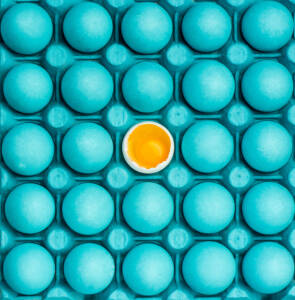Why Meat Alternatives?
The global population is expected to reach 9.8 billion people by 2050, which will naturally cause an increase in food demand. Therefore it’s crucial to drive a transition towards a more sustainable agriculture and food production, starting with products like meat. In fact, 14.5 percent of human-generated GHG emissions are linked with livestock farming, which makes it a pretty un-sustainable business from the start. On the other hand, plant-based and insect-based alternative generate a lower footprint than meat, and of course are also a great way to protect the wellbeing of animals.
This is not to say that meat alternatives don’t have their problems too. For instance, there are many criticisms towards plant-based meat for being highly processed, containing high amounts of salt and conservatives, However, there are a lot of great innovations, which are changing the way we eat and are definitely worth a mention.
Who are the 5 Innovators?
1. Just Egg

Just Egg separated the eggs from the birds. They found that we eat 1.4 trillion chicken eggs per year using plenty of land and water. Using mung beans was a more sustainable option to keep eating scrambled and fluffy eggs. Furthermore, JUST Egg has 67% less saturated fat and a similar amount of protein as a chicken egg.
Key Info
- Type: Plant-based eggs proteins
- Location: United States
- Website: JUST Egg
2. Mosa Meat

Mosa believes that the current consumption will grow with devastating environmental effects. In 2013 they cultivated their first beef burger. After collecting a sample of cells from the best cows, they grow them in the lab with the right amount of nutrients and vitamins. After that, the meat is ready for grilling! They believe that soon they will have the regulatory approval to start grilling in restaurants in the Netherlands.
Key Info
- Type: Making lab-grown beef
- Location: The Netherlands
- Website: Mosa Meat
3. Current Foods

A planted-based sushi experience. They claim that 3.2 billion people rely on fish protein intake. Tuna and Salmon raw fish are made with colour from radish and tomato, texture from bamboo and potato, protein from peas and oil from algae. They seem to have vitamin B12 and omega 3’s from OG fish.
Key Info
- Type: Sea food made from Plants
- Location: United Stated
- Website: CURRENT FOODS
4. Aleph Farms

In 2019 the 1st cultivated meat was grown in space. Steaks from space may be the next solution to lower the climate footprint. They are in the business of growing meat for space and Earth. They have been recognised by World Economic Forum, and UNESCO and they are part of the Private Sector Mechanism to the UN Committee on World Food Security (CFS).
Key Info
- Type: Meat for Space
- Location: Israel
- Website: Aleph Farms
5. SuperMeat

- Type: Making lab-grown chicken
- Location: Israel
- Website: SuperMeat
What can we learn from them?
- Sustainability Claims – key metrics showcasing the reduction of land use and water are always brought up. Methodologies used to support these types of claims are not always clear. However, there is agreeable evidence provided by other sources stating that alternative meat products are more sustainable than meat.
- Transparency – farm-to-fork facility to see how the process works can motivate consumers to
- Speciality – their USP is based on a specific value proposition that consumers can easily relate to, it’s not food or meat in general. It’s a replacement for a specific type of meat (beef or chicken), fish (tuna and salmon) or eggs.
- Inspiring – Aleph Farm from Meat for Space found an inspiring and niche example that was used to test their product.